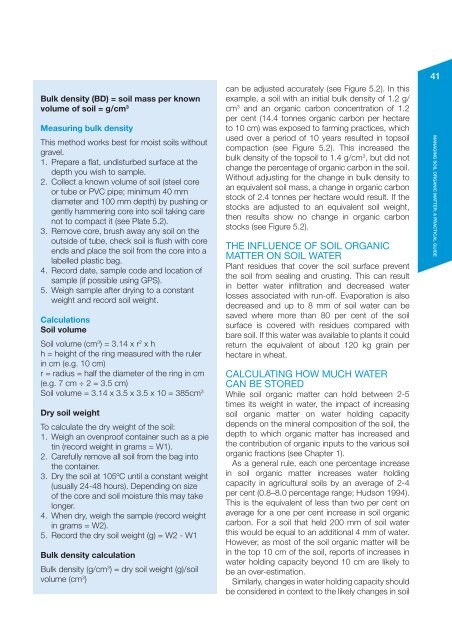managing soil organic matter - Grains Research & Development ...
managing soil organic matter - Grains Research & Development ...
managing soil organic matter - Grains Research & Development ...
You also want an ePaper? Increase the reach of your titles
YUMPU automatically turns print PDFs into web optimized ePapers that Google loves.
Bulk density (BD) = <strong>soil</strong> mass per knownvolume of <strong>soil</strong> = g/cm 3Measuring bulk densityThis method works best for moist <strong>soil</strong>s withoutgravel.1. Prepare a flat, undisturbed surface at thedepth you wish to sample.2. Collect a known volume of <strong>soil</strong> (steel coreor tube or PVC pipe; minimum 40 mmdiameter and 100 mm depth) by pushing orgently hammering core into <strong>soil</strong> taking carenot to compact it (see Plate 5.2).3. Remove core, brush away any <strong>soil</strong> on theoutside of tube, check <strong>soil</strong> is flush with coreends and place the <strong>soil</strong> from the core into alabelled plastic bag.4. Record date, sample code and location ofsample (if possible using GPS).5. Weigh sample after drying to a constantweight and record <strong>soil</strong> weight.CalculationsSoil volumeSoil volume (cm 3 ) = 3.14 x r 2 x hh = height of the ring measured with the rulerin cm (e.g. 10 cm)r = radius = half the diameter of the ring in cm(e.g. 7 cm ÷ 2 = 3.5 cm)Soil volume = 3.14 x 3.5 x 3.5 x 10 = 385cm 3Dry <strong>soil</strong> weightTo calculate the dry weight of the <strong>soil</strong>:1. Weigh an ovenproof container such as a pietin (record weight in grams = W1).2. Carefully remove all <strong>soil</strong> from the bag intothe container.3. Dry the <strong>soil</strong> at 105ºC until a constant weight(usually 24-48 hours). Depending on sizeof the core and <strong>soil</strong> moisture this may takelonger.4. When dry, weigh the sample (record weightin grams = W2).5. Record the dry <strong>soil</strong> weight (g) = W2 - W1Bulk density calculationBulk density (g/cm 3 ) = dry <strong>soil</strong> weight (g)/<strong>soil</strong>volume (cm 3 )can be adjusted accurately (see Figure 5.2). In thisexample, a <strong>soil</strong> with an initial bulk density of 1.2 g/cm 3 and an <strong>organic</strong> carbon concentration of 1.2per cent (14.4 tonnes <strong>organic</strong> carbon per hectareto 10 cm) was exposed to farming practices, whichused over a period of 10 years resulted in top<strong>soil</strong>compaction (see Figure 5.2). This increased thebulk density of the top<strong>soil</strong> to 1.4 g/cm 3 , but did notchange the percentage of <strong>organic</strong> carbon in the <strong>soil</strong>.Without adjusting for the change in bulk density toan equivalent <strong>soil</strong> mass, a change in <strong>organic</strong> carbonstock of 2.4 tonnes per hectare would result. If thestocks are adjusted to an equivalent <strong>soil</strong> weight,then results show no change in <strong>organic</strong> carbonstocks (see Figure 5.2).THE INFLUENCE OF SOIL ORGANICMATTER ON SOIL WATERPlant residues that cover the <strong>soil</strong> surface preventthe <strong>soil</strong> from sealing and crusting. This can resultin better water infiltration and decreased waterlosses associated with run-off. Evaporation is alsodecreased and up to 8 mm of <strong>soil</strong> water can besaved where more than 80 per cent of the <strong>soil</strong>surface is covered with residues compared withbare <strong>soil</strong>. If this water was available to plants it couldreturn the equivalent of about 120 kg grain perhectare in wheat.CALCULATING HOW MUCH WATERCAN BE STOREDWhile <strong>soil</strong> <strong>organic</strong> <strong>matter</strong> can hold between 2-5times its weight in water, the impact of increasing<strong>soil</strong> <strong>organic</strong> <strong>matter</strong> on water holding capacitydepends on the mineral composition of the <strong>soil</strong>, thedepth to which <strong>organic</strong> <strong>matter</strong> has increased andthe contribution of <strong>organic</strong> inputs to the various <strong>soil</strong><strong>organic</strong> fractions (see Chapter 1).As a general rule, each one percentage increasein <strong>soil</strong> <strong>organic</strong> <strong>matter</strong> increases water holdingcapacity in agricultural <strong>soil</strong>s by an average of 2-4per cent (0.8–8.0 percentage range; Hudson 1994).This is the equivalent of less than two per cent onaverage for a one per cent increase in <strong>soil</strong> <strong>organic</strong>carbon. For a <strong>soil</strong> that held 200 mm of <strong>soil</strong> waterthis would be equal to an additional 4 mm of water.However, as most of the <strong>soil</strong> <strong>organic</strong> <strong>matter</strong> will bein the top 10 cm of the <strong>soil</strong>, reports of increases inwater holding capacity beyond 10 cm are likely tobe an over-estimation.Similarly, changes in water holding capacity shouldbe considered in context to the likely changes in <strong>soil</strong>41MANAGING SOIL ORGANIC MATTER: A PRACTICAL GUIDE
















